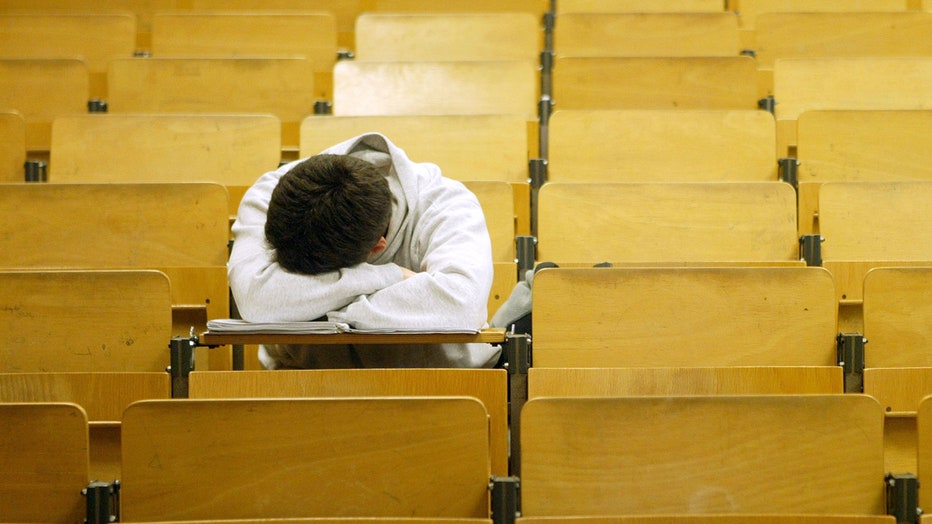Catnap your way to creativity: Study reveals naps may boost creative ideas

Excessive daytime napping could be early indicator of Alzheimer?s disease, study says
Alzheimer?s disease attacks brain regions responsible for wakefulness during the day, the researchers found, adding that wakefulness-promoting neurons in these regions are among the first to be damaged by the disease.
A new sleep study suggests that quick naps may actually spark the creative process – a topic that has been speculated for decades.
Researchers at MIT and Harvard University recruited 50 people to participate in the study, which compared how dreaming during a nap or N1 sleep – the earliest stage of sleep, often called onset sleep – affects post-sleep creative performances.
"In general, the sleep onset period has been characterized as containing spontaneous, vivid dreams, suggesting that it could be an ideal state for creative idea generation," Adam Horowitz, one of the team’s researchers told FOX Television Stations Friday.
In the study, researchers used a technique called targeted dream incubation (TDI). Participants wore a Dormio sleep-tracking device, which tracked their sleep onset through heart rate, muscle tone, auditory cues and verbal reports. TDI allowed the team to deliver spoken cues to the participants and introduce specific themes into the dream during the nap.

A student naps in a lecture hall at the Freie Universitaet January 13, 2003 in Berlin, Germany. The German university system is facing cuts of EUR 75 million in state funding over the next four years as the German government pushes through financial
Two groups were instructed to drift off to sleep and two were asked to close their eyes, stay awake, and let their minds wander as they lay in a dark room.
One of the "sleep" groups was prompted to think about a theme – "trees." Each time Dormio detected sleep, a spoken cue awoke participants and asked them to describe their dreams. It then asked them to drift back to sleep while thinking about a tree. The other sleep group was likewise awakened each time sleep was detected, but they were asked to describe their dreams and return to sleep. The two "awake" groups were prompted every few minutes to describe their thoughts. One group was asked to "continue thinking about a tree," while the other was asked to be mindful of their thoughts.
Following the nap were three creative assessments: writing a story that included the word "tree," listing alternative uses for a tree, and matching words related to trees. These assessments were then scored, measuring the differences in creativity between the four groups to see how much creativity was affected by napping with TDI.
The findings, published on May 15 in Scientific Reports, found that participants in the two sleep groups had higher creativity scores than those in the awake groups.
In fact, participants who napped with TDI performed 43% more creatively (in terms of the Creativity Index) than participants who napped without incubation. Additionally, the group which napped with TDI performed 78% more creatively than those who stayed awake without incubation.
"We found that a period of sleep onset boosts creativity compared to staying awake for the same period," Horowitz continued. "What surprised me most was the ability for a simple intervention (TDI) to facilitate new insight on the mind. People have lived with their thoughts for decades, and to think a whole class of them is waiting barely under the surface to be seen is so exciting."
In addition, participants who dreamt specifically about trees had creativity scores that were significantly higher than those who slept without the cue to think about trees. They outperformed those who stayed awake in both groups by even more.
Those that dreamed about a tree multiple times also did better than a subject who dreamt about a tree one time.
"This is the first study to show that incubating dreams can boost post-sleep creativity on tasks related to the incubated theme," Horowitz explained, adding, "This is a novel scientific breakthrough, both for understanding the role of sleep and dreams and for the general public, who may be able to apply these findings to boost their own creative ideation."
The researchers noted that the study was limited to the topic and tasks investigated by the study, so further work will be needed to generalize these results to other creative domains, tasks and TDI topics.
The team is also currently exploring TDI with later stages of sleep, along with the use of TDI in therapeutic settings.
These findings align with a 2021 study, which also found a creative boost associated with sleep onset on a number-related insight task.
And while naps may be able to boost creativity, some studies have linked longer naps to health issues including obesity and high blood pressure.
RELATED: Study finds link between long naps and obesity, high blood pressure
Last month, a research team discovered that people who took naps exceeding 30 minutes were more vulnerable to a higher body mass index, higher blood pressure, and a cluster of other conditions associated with heart disease and diabetes compared to those without naps.
This story was reported from Los Angeles.

